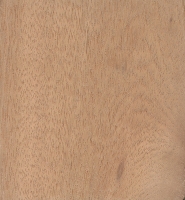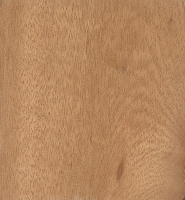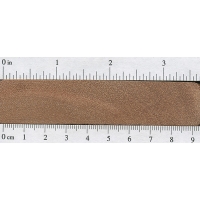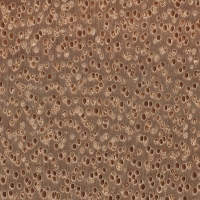 |
Common Name(s): Deglupta, Kamarere, Mindanao gum Scientific Name: Eucalyptus deglupta Distribution: Southeast Asia (also grown on plantations throughout tropics) Tree Size: 100-200 ft (30-60 m) tall, 3-6 ft (1.2-1.8 m) trunk diameter Average Dried Weight: 31 lbs/ft3 (500 kg/m3) Specific Gravity (Basic, 12% MC): .38, .50 Janka Hardness: 650 lbf (2,880 N) Modulus of Rupture: 11,550 lbf/in2 (79.6 MPa) Elastic Modulus: 1,565,000 lbf/in2 (10.79 GPa) Crushing Strength: 6,780 lbf/in2 (46.7 MPa) Shrinkage: Radial: 3.8%, Tangential: 8.5%, Volumetric: 15.5%, T/R Ratio: 2.2 |
Color/Appearance: Heartwood is a light to medium red. Sapwood is a pale yellowish brown, though not always clearly demarcated from the heartwood. Quartersawn surfaces exhibit a ribbon-stripe pattern.
Grain/Texture: Grain is interlocked, with a uniform medium to coarse texture and good natural luster.
Endgrain: Diffuse-porous; exclusively solitary; very large pores in diagonal/radial arrangement, few; parenchyma vasicentric; narrow rays, spacing fairly close.
Rot Resistance: Rated as non-durable; poor insect resistance.
Workability: Generally easy to work with hand or machine tools, though tearout is common on quartersawn surfaces due to the strongly interlocked grain. Glues and finishes well.
Odor: No characteristic odor.
Allergies/Toxicity: Besides the standard health risks associated with any type of wood dust, no further health reactions have been associated with Deglupta. See the articles Wood Allergies and Toxicity and Wood Dust Safety for more information.
Pricing/Availability: Many trees are harvested for pulp, though it is infrequently available as lumber. Prices should be moderate for an imported hardwood.
Sustainability: This wood species is not listed in the CITES Appendices or on the IUCN Red List of Threatened Species.
Common Uses: Paper (pulpwood), veneer, furniture, and millwork.
Comments: The tree is sometimes called Rainbow Eucalyptus because the tree’s bark is frequently multi-colored as outer patches are shed, producing an interesting array of hues. Deglupta is also sometimes sold under the trade name Kamarere.
Plantation-grown stock tends to be much lighter and softer than wild-grown trees, though lumber from plantation trees is also easier to dry without complications; the wood is one of the softest of all the commercially available Eucalyptus species. Mechanical data listed above is for plantation-grown wood.
- Blue Gum (Eucalyptus globulus)
- Brown Mallee (Eucalyptus dumosa)
- Coolibah (Eucalyptus coolabah)
- Jarrah (Eucalyptus marginata)
- Karri (Eucalyptus diversicolor)
- Lyptus® (Eucalyptus urograndis)
- Messmate (Eucalyptus obliqua)
- Mountain Ash (Eucalyptus regnans)
- Red Mallee (Eucalyptus oleosa)
- River Red Gum (Eucalyptus camaldulensis)
- Rose Gum (Eucalyptus grandis)
- Swamp Mahogany (Eucalyptus robusta)
- White Box (Eucalyptus hemiphloia)
- Yellow Box (Eucalyptus melliodora)
- Yellow Gum (Eucalyptus leucoxylon)
None available.
Scans/Pictures: A special thanks to Per Stangegaard for providing the wood sample of this wood species.








Common in Hawaii, where it is made into a variety of objects; usually a delicate blushing pink, with poorly demarcated pale yellow and beige stripes